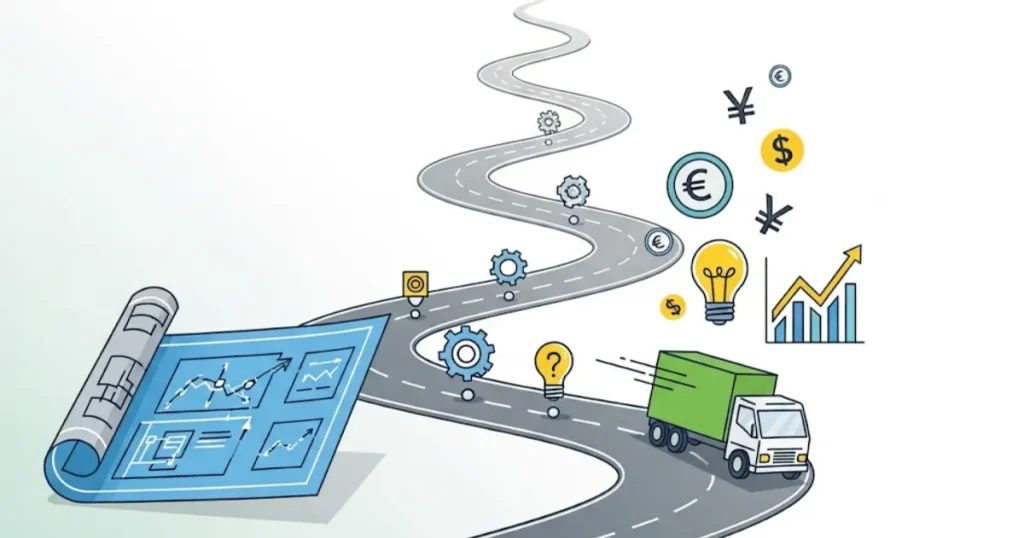Building a delivery team for your business feels like assembling a puzzle while blindfolded - you know the pieces matter, but figuring out how they fit together can drive you crazy. Whether you're running a local bakery that just added delivery or an ecommerce startup scaling beyond your garage, getting your business delivery operations right can make or break customer satisfaction.
The delivery industry is booming, with the global last-mile delivery market expected to reach$258.68 billion by 2030. But here's the kicker: 84% of customers won't order again after just one bad delivery experience. That's like losing a customer forever because your pizza arrived cold, harsh but true.
The good news? Building an effective delivery team doesn't require a logistics degree or a fortune in startup capital. It just needs the right strategy, smart planning, and a system that works for your specific business size and budget.
Understanding Your Delivery Needs Before You Hire
Before you start posting "delivery driver wanted" ads everywhere, take a step back and assess what you actually need. Think of this like buying groceries when you're hungry - you'll end up with three bags of snacks and no actual dinner plan.
Start by analyzing your current order volume and delivery zones. Are you handling 20 deliveries a week within 5 miles, or 200 deliveries across three counties? A local flower shop needs a completely different logistics team setup than a meal kit company serving an entire metropolitan area.
Consider your delivery windows too. Same-day delivery sounds impressive, but it requires more drivers, better coordination, and higher operational costs. Sometimes, next-day delivery with reliable tracking beats same-day chaos every time.
Map out your busiest days and peak hours. Most restaurants see dinner rushes, while retail businesses might peak during lunch breaks when people are shopping online. This data helps you decide between full-time employees, part-time contractors, or a hybrid approach.
The Smart Way to Handle Delivery Team Recruitment

Delivery driver recruitment is where many businesses stumble. They either hire too quickly (hello, reliability issues) or overthink it so much that they never actually hire anyone (hello, owner burnout).
Here's a practical approach: Start with clear job descriptions that spell out expectations. Include delivery zones, vehicle requirements, and typical daily responsibilities. Be upfront about pay structure - hourly wages plus mileage, per-delivery rates, or commission-based models all work differently for different drivers.
Look for candidates with clean driving records, obviously, but also consider reliability indicators like stable employment history and good communication skills. A driver who can't text "running 10 minutes late" will frustrate customers more than you'd expect.
Consider starting with 2-3 part-time drivers rather than one full-time employee. This gives you flexibility during sick days or busy periods without the overhead of full benefits packages. This is perfect for smaller businesses testing the waters.
Don't forget about vehicle considerations. Will drivers use their own cars (cheaper for you, but limits who can apply) or will you provide company vehicles (more control, higher costs)? Each approach has pros and cons worth considering carefully.
Essential Tools and Systems for Delivery Team Management

Effective delivery team management runs on good systems, not good intentions. You need tools that handle route optimization, real-time tracking, and customer communication without requiring a computer science degree to operate.
Route Planning Software: Tools like Route4Me or OptimoRoute help drivers avoid traffic and complete deliveries efficiently. A well-planned route can save 30% on fuel costs and delivery time, that's like getting an extra day's worth of deliveries for free.
Communication Systems: Group messaging apps like WhatsApp Business or Slack keep your team connected. Drivers can share updates, ask questions, and coordinate with dispatchers in real-time. No more playing phone tag during rush periods.
Customer Tracking: Platforms like AfterShip or simple SMS updates keep customers informed. When people know their order is "5 stops away," they're less likely to call asking where their delivery is, saving your team time and reducing stress.
Performance Tracking: Simple spreadsheets work for small teams, but delivery management software helps track metrics like average delivery time, customer ratings, and fuel efficiency as you grow.
Managing Operations Without Losing Your Mind
Once your delivery team is running, the real challenge becomes business delivery operations management. This is where small details make big differences in customer satisfaction and profitability.
Create standard operating procedures for common scenarios. What happens when nobody's home? How do drivers handle damaged packages? When do they call customers versus leaving items at the door? Clear protocols prevent confusion and ensure consistent service.
Set up regular check-ins with your drivers - not to micromanage, but to catch issues early. Weekly 15-minute team calls help identify problem routes, customer concerns, or equipment needs before they become major headaches.
Monitor your key metrics closely: on-time delivery rate, customer satisfaction scores, and cost per delivery. If your on-time rate drops below 90%, investigate quickly. Maybe routes need adjusting, or you need additional drivers during peak times.
Build relationships with backup solutions. Partner with local courier services for overflow periods or emergency deliveries. Having a Plan B prevents you from disappointing customers when your primary team gets overwhelmed.
When to Scale Your Delivery Team
Knowing when to expand your delivery team is crucial. Scale too early and you're paying for unused capacity. Scale too late and you're turning away customers or burning out existing drivers.
Watch for these scaling signals: drivers consistently working overtime, delivery windows getting longer, or customer complaints about delays increasing. If you're regularly telling customers "we're booked until next week," it's time to hire.
Plan your expansion in phases. Add one driver at a time and monitor the impact on efficiency and costs. Sometimes adding a second driver improves your first driver's performance by reducing their workload and stress.
Consider specialization as you grow. Some drivers might excel at quick urban deliveries while others prefer longer suburban routes. Playing to individual strengths improves overall team performance and job satisfaction.
Take the Next Step From Planning to Profitable Delivery

Building an effective delivery team transforms your business from "we'll figure out shipping later" to "customers love our reliable service."
Ready to build a delivery team that actually delivers results? The strategies are clear, but implementing them while running your core business can feel overwhelming. That's exactly why Shopinbos exists - to help first-time eCommerce sellers and growing businesses navigate operational challenges with confidence.
At Shopinbos, we specialize in breaking down complex business operations into manageable, beginner-friendly steps. From delivery team setup guides to vendor management resources, we provide the insights you need to make smart decisions without expensive consultants or overwhelming complexity.
FAQs
How much should I pay delivery drivers?
Pay varies by location and model, but expect $15-25/hour plus vehicle expenses, or $3-8 per delivery for contractors. Research local rates and factor in fuel costs, vehicle wear, and insurance considerations when setting compensation.
Should I hire employees or independent contractors?
Employees give you more control over schedules and service standards but cost more in taxes and benefits. Contractors offer flexibility and lower overhead but less direct control. Many small businesses start with contractors and transition to employees as they grow.
What insurance do I need for a delivery team?
You'll need commercial auto insurance if providing vehicles, general liability insurance, and potentially workers' compensation depending on your state and employee classification. Consult with a business insurance agent for specific requirements.
How do I handle customer complaints about deliveries?
Create a clear complaint resolution process. Train drivers to stay professional, document issues, and escalate when necessary. Most problems stem from communication gaps, keep customers informed and address issues quickly and honestly.

